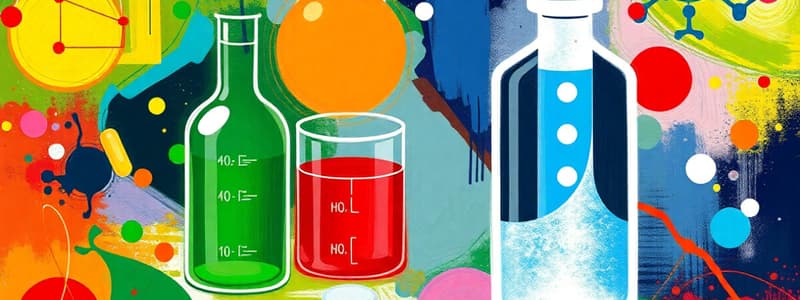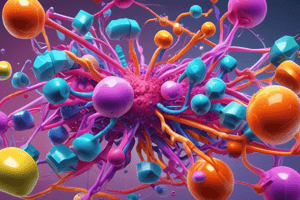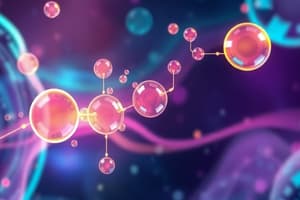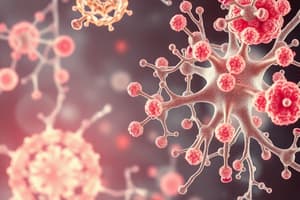Podcast
Questions and Answers
Why are acids and bases important in pharmacy regarding drug properties?
Why are acids and bases important in pharmacy regarding drug properties?
- They only affect the taste of the medication.
- They can affect how a drug interacts with other compounds or receptors and its capability to pass across lipid membranes. (correct)
- They solely determine the color of the drug.
- They solely influence the manufacturing cost of the drug.
Approximately what percentage of drugs are basic?
Approximately what percentage of drugs are basic?
- 50%
- 75% (correct)
- 20%
- 5%
Why might the formulation of a medication need to be changed if the drug is acidic or basic, especially for sensitive applications such as skin?
Why might the formulation of a medication need to be changed if the drug is acidic or basic, especially for sensitive applications such as skin?
- To reduce the drug's manufacturing cost.
- To increase the drug's solubility in water.
- To improve the drug's color and make it more appealing.
- To prevent the drug from causing irritation or aggravation. (correct)
What aspect of a drug's behavior is most directly related to its stability after manufacturing?
What aspect of a drug's behavior is most directly related to its stability after manufacturing?
What is the Brønsted-Lowry definition of a base?
What is the Brønsted-Lowry definition of a base?
How does the extent of dissociation affect the strength of an acid or base?
How does the extent of dissociation affect the strength of an acid or base?
What is produced when acids and bases dissociate in aqueous solutions?
What is produced when acids and bases dissociate in aqueous solutions?
What is the relationship between the strength of an acid and its conjugate base?
What is the relationship between the strength of an acid and its conjugate base?
What term describes solvents, like water, that can act as either an acid or a base?
What term describes solvents, like water, that can act as either an acid or a base?
According to the information, which of the following are considered 'STRONG' acids and bases?
According to the information, which of the following are considered 'STRONG' acids and bases?
What is a key characteristic of strong acids and strong bases in terms of ionization?
What is a key characteristic of strong acids and strong bases in terms of ionization?
What is true about most drugs with acidic or basic functional groups?
What is true about most drugs with acidic or basic functional groups?
According to the provided information, what does the acidity constant ($\text{K}_a$) measure?
According to the provided information, what does the acidity constant ($\text{K}_a$) measure?
What is the relationship between the strength of an acid and its $\text{K}_a$ value?
What is the relationship between the strength of an acid and its $\text{K}_a$ value?
Why is pKa used as a more convenient measure of acidity compared to Ka?
Why is pKa used as a more convenient measure of acidity compared to Ka?
How is pKa mathematically related to Ka?
How is pKa mathematically related to Ka?
What is the primary reason pKb is not as frequently used as a measure of base strength when comparing different drugs?
What is the primary reason pKb is not as frequently used as a measure of base strength when comparing different drugs?
How can the pKa of a basic drug be calculated if its pKb is known, assuming pKw (ionization constant of water) is 14?
How can the pKa of a basic drug be calculated if its pKb is known, assuming pKw (ionization constant of water) is 14?
For a basic drug, what does the pKaH value typically represent?
For a basic drug, what does the pKaH value typically represent?
What is the equation to use to work out the base strength (pKb) of the ‘free base’?
What is the equation to use to work out the base strength (pKb) of the ‘free base’?
What is a key factor influencing the significant difference in basicity between pethidine and benzocaine?
What is a key factor influencing the significant difference in basicity between pethidine and benzocaine?
What is required to form a stable salt?
What is required to form a stable salt?
Why are salts prefered for manufacturing?
Why are salts prefered for manufacturing?
What is LogD a better predictor than LogP for?
What is LogD a better predictor than LogP for?
What does LogP measure?
What does LogP measure?
Flashcards
Acids and Bases
Acids and Bases
Molecules that can exist as charged ions or uncharged.
Molecule properties
Molecule properties
The way a molecule interacts with other substances/receptors, its stability, solubility, and ability to cross lipid membranes.
Brønsted-Lowry definition
Brønsted-Lowry definition
Acids donate protons; bases accept them.
Acid/Base Strength
Acid/Base Strength
Signup and view all the flashcards
Conjugate pairs
Conjugate pairs
Signup and view all the flashcards
General rule
General rule
Signup and view all the flashcards
Acid/Base Ionization
Acid/Base Ionization
Signup and view all the flashcards
Acidic drugs
Acidic drugs
Signup and view all the flashcards
Basic drugs
Basic drugs
Signup and view all the flashcards
Ka
Ka
Signup and view all the flashcards
pKa
pKa
Signup and view all the flashcards
pKw
pKw
Signup and view all the flashcards
Salts
Salts
Signup and view all the flashcards
LogP
LogP
Signup and view all the flashcards
LogD
LogD
Signup and view all the flashcards
Study Notes
- Many chemical molecules are acids or bases and can exist as ions or uncharged molecules.
- The properties of ions and non-ions differ and can be used to predict the properties of a molecule, including:
- How it reacts with other compounds/receptors
- Stability
- Solubility in different solvents like water
- Capability to pass across lipid membranes to reach the site of action.
- 75% of drugs are basic, 20% are acidic, and 5% are neither.
- Medications for sensitive areas like skin should not cause irritation, thus formulations may need adjustment.
- Drug degradation in contact with moisture depends on pH.
- A 2014 study found that most drugs have ionizable groups and dissociate within a biological system.
- According to the Brönsted-Lowry definition:
- An acid donates a proton in a reaction.
- A base accepts a proton in a reaction.
- Hydrochloric acid donates a proton to water, acting as a base, thereby behaving as a Brönsted-Lowry acid.
- Sodium hydroxide dissociates in water, and the formed OH- ions function as a Brönsted-Lowry base by accepting a proton.
- An acid or base's strength is determined by its extent of dissociation.
- Greater dissociation means a stronger acid or base.
- Hydrochloric acid fully dissociates in aqueous solution.
- Acetic acid is a weak acid that only partially dissociates.
- Acids and bases in aqueous solutions produce conjugate pairs, consisting of ionized and non-ionized species.
- HCl fully dissociates, and Cl- ions do not readily accept a proton.
- HCl is a strong acid, and its conjugate ion (Cl-) is a weak base.
- Acetic acid does not dissociate much, therefore CH3COOH will not readily donate a proton to produce CH3COO-.
- Acetic acid is a weak acid, and its conjugate ion (CH3COO-) is a strong base.
- A general rule: a weak acid is associated with a strong conjugate base, and vice versa.
- Water can act as an acid or a base and is called an amphiprotic solvent.
- In the presence of an acid (HA) water acts as a base and when a base is present water acts as an acid.
- Mineral acids like HCl and H2SO4, and common bases like NaOH and Ca(OH)2 are generally considered "STRONG".
- Strong acids and bases are fully ionized.
- Most drugs with acidic or basic functional groups are "weak" acids/bases.
Acidic and Basic Drugs
- Fusidic acid, a topical antibiotic with pKₐ 5.35, shows that charged species are ionized or dissociated.
- Strong acids have weak conjugate bases.
- Weak acids have strong conjugate bases.
- Pethidine is an opioid analgesic with a pKa of 8.7 that is used for moderate to severe pain and commonly used in obstetrics.
- A strong base has a weak conjugate acid.
- A weak base has a strong conjugate acid.
- Unprotonated bases are often called a "free base".
- Water functions as a weak acid and a weak base.
Acidity Constant
- Kₐ is the acidity constant, defined as Kₐ = [H3O+][A-]/[HA] for acid HA.
- Acids are proton donors, and in aqueous solution, they are hydrated.
- Stronger acids have higher Kₐ values.
- Benzylpenicillin has a Kₐ of 1.6 x 10⁻³, with the equilibrium lying to the left.
- pKₐ is a convenient measure of acidity because Kₐ ranges can be large.
- pKₐ = -log Kₐ.
- For benzylpenicillin, pKₐ = -log (1.6 x 10⁻³) = 2.80.
- Amides (CONR₂) are NEUTRAL functional groups.
Basicity Constant
- K is the basicity constant, defined as K = [BH₂+][OH-]/[BH] for base BH.
- Bases accept protons and stronger bases have higher K .
- pK is used to measure basicity, with ranges of K being very large.
- pK is rarely used to measure base strength, it is helpful to compare ALL drugs on the same scale.
- The pK of a basic drug is calculated as pKₐ + pK = pK = 14, where pK is the ionization constant of water.
- pK can also be thought of as the pK of the conjugate acid (pKaH).
- In the equilibrium BH₂⁺ + H₂O ⇌ BH + H₃O⁺, Kₐ = [H₃O⁺][BH]/[BH₂⁺], so pKₐ or pKaH = -log Kₐ.
- The pKₐ of pethidine is 8.7 as found the scientific literature.
- The chemical structure of pethidine contains an amine basic functional group, not any acidic functional groups.
- The quoted value "pKₐ = 8.7" is the pK of the conjugate acid.
Base Strength
- To find the base strength (pK_b) of the ‘free base’, use the equation: pKₐ + pK_b = pKw.
- Given that pKₐ for benzocaine is 2.8, the pK_b is calculated as:
- 2.8 + pK_b = 14, therefore pK_b = 11.2.
- Pethidine is approximately 1 million (10⁶) times more basic than benzocaine on a log scale.
- Basicity reflects the ability to accept a proton, explained by the nucleophilicity of amines.
- Aromatic rings reduce nucleophilicity because electrons are shared with the π-cloud.
- Aliphatic groups increase nucleophilicity donating electron density to the lone pair.
- Drugs can have multiple acidic and/or basic functional groups.
- Fusidic acid has three pKₐ values in theory while only the initial is measured.
- The totally ionized form of fusidic acid, has three negative charges which makes it unstable.
- Second and third pK values differ from the expected value and become less acidic because the conjugate base is disfavored.
Salt Formation
- Acids and bases can form salts.
- Salts are ionic with greater aqueous solubility.
- Salts have higher melting points than the original acid or free base (often 50-100 °C higher).
- They offer better pharmaceutical properties for milling the powders.
- Stable salt formation needs a pKₐ difference of three units to ensure that the equilibrium lies to the right.
- Hydrochloride salts are a common formulation for basic drugs and are very acidic.
- Methanesulfonic acid is a strong acid (Kₐ = 1 x 10², pKₐ = -2).
- It's used as a counter-ion in drug salts and offers alternative properties to HCl.
- Imatinib has basic functional groups, and no acidic functional groups.
- The pKₐ values of the conjugate acid are 5.93, 10.27, 11.44, and 12.48.
- Methansufonic acid salt is recognized as mesylate or mesilate
- "Mesilate" means "methanesulfonate."
- A large pKₐ difference makes it a pharmaceutical counter-ion.
- Many basic sites mean lots are ionized, which means the remaining groups become hard to ionize as the molecule charges up.
- There is less than 100mg of imatinib in 100mg of imatinib mesylate.
- LogP measures drug polarity, helping predict drug solubility and membrane permeation.
- The distribution coefficient D, is better for ionizable drugs and it's better at predicting absorption and membrane permeability than logP.
- D = [HX]lipid phase / ([HX]aq + [X-]aq), where HX is an acidic drug
- LogD is harder to measure in practice than logP.
- LogP is used more widely and it's easier to compare to non-ionizable drugs.
Studying That Suits You
Use AI to generate personalized quizzes and flashcards to suit your learning preferences.




